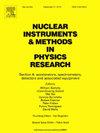Quality assurance tests and techniques to investigate and improve hermeticity of ATLAS Phase II Resistive Plate Chamber detectors
IF 1.5
3区 物理与天体物理
Q3 INSTRUMENTS & INSTRUMENTATION
Nuclear Instruments & Methods in Physics Research Section A-accelerators Spectrometers Detectors and Associated Equipment
Pub Date : 2025-04-10
DOI:10.1016/j.nima.2025.170510
引用次数: 0
Abstract
The Phase II upgrade of the ATLAS Muon Spectrometer will involve the installation of approximately 1000 next-generation single Resistive Plate Chamber (RPC) detectors, also referred to as singlets. This upgrade aims to enhance detector coverage, increase hit efficiency, and improve timing precision, ultimately strengthening the precision and robustness of the muon trigger system. The upgrade is essential for maintaining the performance of the muon spectrometer in the high-luminosity environment of the HL-LHC, where increased radiation and event rates pose significant challenges. Currently, detector production is underway, with gas gaps being produced in Italy. To ensure the integrity of these gas gaps, especially their mechanical properties and gas tightness, several investigative techniques have been proposed and implemented.
This study discusses the results of Thermal Cycling tests performed on ATLAS RPC gas gaps. These tests were conducted between C and C in a climate room at University of Cambridge and C and C in laboratories at INFN Frascati, providing insights into the effects of mechanical stress due to thermal expansion on gas leaks. Additionally, it outlines various methods employed to assess and enhance the gas tightness of the detectors. The ultimate objective is to produce hermetic RPC detectors, minimising the emission of environmentally harmful gases and mitigating their impact on global warming.
求助全文
约1分钟内获得全文
求助全文
来源期刊
CiteScore
3.20
自引率
21.40%
发文量
787
审稿时长
1 months
期刊介绍:
Section A of Nuclear Instruments and Methods in Physics Research publishes papers on design, manufacturing and performance of scientific instruments with an emphasis on large scale facilities. This includes the development of particle accelerators, ion sources, beam transport systems and target arrangements as well as the use of secondary phenomena such as synchrotron radiation and free electron lasers. It also includes all types of instrumentation for the detection and spectrometry of radiations from high energy processes and nuclear decays, as well as instrumentation for experiments at nuclear reactors. Specialized electronics for nuclear and other types of spectrometry as well as computerization of measurements and control systems in this area also find their place in the A section.
Theoretical as well as experimental papers are accepted.

 求助内容:
求助内容: 应助结果提醒方式:
应助结果提醒方式:


